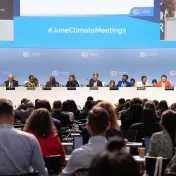GENERAL ASSESSMENT >>
CRUNCHPOINTS OF THE NEGOTIATIONS >>
1. Ambition >>
2. Negotiations on Article 6 >>
3. Climate-related loss and damage >>
4. Climate finance >>
OUTLOOK >>
GENERAL ASSESSMENT
The outcome of the World Climate Conference (COP25) in Madrid, held 2 to 15 December 2019, clearly shows the strengths and weaknesses of the Paris Agreement. It shows that the days of cosmetic climate policy are over, but also that the coordinated resistance of the brakemen is growing as a result.
The strength of the Paris Agreement: It is now clear to all states that it is a matter of a rapid worldwide phase-out of coal, oil and gas. Some states such as the USA, Brazil and Australia, whose governments are closely linked to the coal, oil and agricultural lobbies, are feeling the effects of the Paris Agreement and trying to organise massive resistance against it. However, the vast majority of states want to take both the farewell to fossil fuels and support for those particularly affected by the climate crisis to a new level. In implementing the Paris Agreement in their respective countries, they finally want to put an end to climate policy in homeopathic doses.
The weakness of the Paris Agreement: In a consensus, the necessary transformative steps cannot be implemented with this polarisation. Under Chile's presidency, the COP25 therefore ended with weak compromises. At least, parties decided on an impulse for more ambition and on the defence against large loopholes. Under the partly chaotic leadership of a weakened Chilean Presidency, a coalition of progressive countries around Costa Rica, many EU-countries, the island states and the least developed countries was not sufficient, however, to completely overcome the blocking countries' braking policy.
Germany and the EU must now enter into partnerships with key countries such as China, India and South Africa in order to present improved national climate targets and plans in good time next year. The European Green Deal announced during the climate summit is a very good basis for geopolitically powerful alliances between the EU and Germany in this direction. In order to find a way out of the current trough of multilateralism, the European Union, under the German Presidency in 2020, together with China, India and Russia as well as progressive US states – together responsible for more than 50% of global emissions – must lead the way with increased climate protection targets and far-reaching sectoral transformations. Such a pioneering role makes Germany and the EU attractive for political and economic-technical cooperation with important emerging economies.
THE CRUNCH POINTS OF THE NEGOTIATIONS
1. Ambition
The countries' climate efforts must be measured against the three objectives of the Paris Agreement:
- to limit global temperature rise to well below 2°C, better 1.5°C,
- to build up resilience and
- to redirect financial flows in such a way as to achieve the first two objectives.
To this end, an important 2020 process for enhancing the national climate targets (nationally determined contributions, NDCs) was established in Madrid. The decision text refers to a decision taken during the Paris COP in 2015 calling on countries to update their NDCs. However, the resilience target and even more the goal of redirecting financial flows still fall short in most NDCs. The improvement of the adaptation plans in the NDCs process for 2020 was, however, given greater consideration. The UN Climate Secretariat (UNFCCC) is to summarise the submitted NDCs in a synthesis report to be presented at COP26 in November 2020 on the status of the collective ambition of all countries.
In Madrid, it has not yet been possible to firmly anchor the three central Paris objectives (temperature targets, resilience, redirection of financial flows) as a regular yardstick for the success of the Paris Climate Agreement.
This agreement on the ambition text was possible because a process was set up on pre-2020 action, which emerging countries such as China and India had called for. Their aim is to draw conclusions from the fact that many industrialised countries have fallen behind their Paris commitments to improve their climate change targets and financial commitments by 2020. Some industrialised countries (USA and Canada) have not even achieved their Kyoto (1997) targets. Germany will clearly miss its climate target for 2020 (40% compared to 1990), which was also announced internationally in Paris, and will probably not reach it until the middle of the next decade. The decision has now been taken:
Roundtables and a report will inform the Global Stocktake in 2023. It is already clear that if the industrialised countries do not present a coherent strategy for making up with what they have not achieved through increased targets, additional climate financing or cooperation partnerships, this will – just as at COP25 – have a negative impact on the willingness of the emerging countries to act progressively.
One positive aspect to emphasise is the strengthened role of science in the ambitious decision. International pressure from Fridays4Future ("Unite behind the science") in particular has made it possible for the role of science and the Intergovernmental Panel on Climate Change (IPCC) – still under considerable attack last year, in particular from Saudi Arabia – to now be positively acknowledged. Brazil and Argentina had long resisted the explicit reference to the IPCC reports on land use and oceans. Having succeeded in reaching an agreement with Argentina and thus isolating Brazil, the country's government finally agreed in the closing plenary session after considerable pressure from many other countries.
The important reference to the fact that the NDC enhancement must be carried out with public participation is unfortunately not included in the decision text on ambition. Nevertheless, the expectations of the majority of states became clear, but in view of the growing number of authorially governed or minded states it was not possible to achieve consensus. This is important in order to take social dimensions into account and to make just transition possible.
At the special summit of UN Secretary-General Guterres in September 2019, only developing countries had so far pledged to enhance their NDCs in 2020. It was fascinating to see how strongly the number of countries has risen that have announced that they will be greenhouse gas neutral by 2050. In the Climate Ambition Coalition, 120 countries have announced this (closing speech by Chilean COP President Carolina Schmidt). 80 states have also announced that they intend to tighten their climate targets and plans (NDCs) for 2030. In addition, eleven countries have initiated NDC enhancement processes for the 2020 targets.
On the official last day of the COP25 negotiations, the so-called High Ambition Coalition (with Marshall Islands, Germany, France, the United Kingdom, the European Commission, Canada, Norway, Ethiopia, etc.) met to make the decisions more solid by calling for more ambition from all countries. Frans Timmermans, Executive Vice President for the European Green Deal in the EU Commission, also made it clear that after the EU decision on greenhouse gas neutrality by 2050, it must now be possible to implement concrete plans within the framework of the European Green Deal. Even though negotiations with Poland on how and with what support they can achieve the goal still have to be concluded by June, the EU governments have thus paved the way for central projects of the European Green Deal. The Deal, together with the GHG neutrality target, is essential for the EU's long-term strategy, also to be submitted to the UNFCCC in 2020.
It is now necessary that the EU, following a corresponding impact analysis, commits itself to the target corridor of 50-55% reduction by 2030 at the latest in June 2020, in order to generate momentum for other G20 countries on this basis as well. The EU-China Summit in Leipzig in September 2020 will play a central role in this. At the same time, Germany is very well positioned to conduct bilateral negotiations with India, South Africa, Indonesia and Russia. Within the framework of such a jointly organised movement, the EU should then at least anchor the higher target of -55% in its new NDC, which must be available in time for the climate summit in Glasgow in November 2020. The German government must support this – the Ministry of Economics is still blocking it.
2. Negotiations on Article 6 – market mechanisms
The compromise proposed in the so-called Article 6 for the crediting of climate protection credits under pressure from brakemen such as Brazil and, in this case, India, was rejected by many states because it would have led to less rather than more ambition. Negotiations will continue next year in Glasgow under the British COP Presidency. In Germanwatch's view, robust market rules are indispensable. These negotiations were one of the key points of the COP25. The aim is to regulate future international trade in emissions and emission reductions. If cleverly designed, this could lead to additional and far-reaching emission reduction, strengthen the cost efficiency of international mitigation efforts and lower market entry barriers for climate-friendly technologies in developing countries. This could also generate revenue for the important Adaptation Fund.
Such a constructive role of market mechanisms would require a robust regulatory framework that preserves environmental integrity, promotes increased ambition and guarantees human rights and social standards. In particular, double counting would have to be avoided. In addition, no old Kyoto certificates should be counted towards future climate targets. Both would amount to a reduction of the climate targets agreed in Paris. In addition to ambitious reference scenarios, a substantial automatic cancellation rate is needed to enable additional and more far-reaching emission reductions. This would ensure that part of each certificate would not benefit the buyer or user, but would increase the ambition of the Paris Agreement.
The negotiations on Article 6 were already the focus of media interest in the run-up to the COP25, as they could not be concluded last year at the COP24 in Katowice, Poland – in particular because Brazil was fighting for the huge loophole of double counting.
The negotiations in Madrid were also extremely difficult due to differing positions of the states. Brazil and India in particular, but also Egypt, Saudi Arabia and Australia, attempted to negotiate considerable climate policy loopholes into the rules and regulations for different reasons and to soften or remove from the text important levers for increasing ambition and security anchors for human rights.
Not least in response to these difficult negotiations, a number of states finally joined the so-called "San José Principles" initiated by Costa Rica. These are a series of principles that, in Germanwatch's view, would have made a robust set of rules possible if they were supplemented by corresponding security mechanisms for human rights and social standards. After ten states initially backed the principles initiated by Costa Rica, Germany was the first G20 state to join the initiative and thus set an important example for climate diplomacy. By the end of the world climate conference, a total of 30 states had joined the principles, including 17 EU member states. From Germanwatch's point of view, it is very welcome that the German delegation has assumed an important leadership role in this difficult atmosphere of COP25.
Unfortunately, despite this important advance under a much weakened Chilean Presidency, it was not possible to produce a truly ambitious draft text. Instead, the Presidency's drafts contained considerable risks to environmental integrity, such as possible double counting and the potential takeover of old Kyoto certificates. The last text provided for central decisions on the concrete design of these loopholes to be postponed into the future, so that their exact extent would have remained completely unclear. The texts also remained completely inadequate with regard to the protection of human rights and social standards. Decisions on the possible inclusion of appropriate social security mechanisms should be postponed for many years into the future. Furthermore, it was not possible to anchor sufficient instruments in the draft text to ensure that this form of eligible environmental credit is not a zero-sum game, but a plus-sum game for the climate.
Ultimately, the uncompromising nature of a few states to negotiate large loopholes in the agreement made it impossible for progressive states to agree to a compromise in the Article 6 negotiations. The negotiations could not be concluded at COP25 and are to be continued next year instead. In Germanwatch's view, this was necessary to prevent weak rules for future market mechanisms from leading to a considerable danger for international climate protection and also to a considerable reputational risk for participating companies. It was gratifying to see how many countries did not want a deal at any price, including environmental integrity. The demonstrated willingness to defend the Paris Agreement was very gratifying.
Looking ahead, the negotiations on Article 6 must now be continued at COP26 in Glasgow. Here too, the aim must be for future carbon markets to lead to more and not less global climate protection through robust rules. A renewed leadership role for the San José Group, whose principles should be supplemented by human rights principles, with active German participation would be an important sign of this.
3. Climate-related loss and damage
The signs of an escalating climate crisis can no longer be ignored. Expectations of the COP25 on how to deal with the unavoidable consequences of climate change (climate-related loss and damage, L&D) were therefore high: On the one hand, concrete next steps were needed to break the long-standing ideological blockade of all industrialised countries and, even more so, financial support for affected developing countries with regard to unavoidable damage. On the other hand, the review of the Warsaw International Mechanism (WIM) should ensure that it is in a position to effectively support vulnerable countries in dealing with L&D and meet their needs, also with regard to future climate damage.
The results of COP25 broke the blockade by recognising the need to support developing countries in dealing with loss and damage caused by the climate crisis. An important step in this direction is the first-time anchoring of loss and damage under the UNFCCC financial architecture. The significance of this step can only be assessed against the background of the 10-year blockade of this recognition by the industrialised countries. Nevertheless, this step has a symbolic significance for the time being. UN Secretary-General Guterres had announced this climate summit as an "emergency summit". However, what has now been set in motion is in no way appropriate to the scale of the challenge for the people and states affected by the climate crisis.
The vague wording regarding the future financing of loss and damage could give the impression that the industrialised countries are shifting their responsibility for financial support onto the private sector and non-governmental organisations. De facto, we expect that there will be a much greater willingness on the part of industrialised countries to provide additional funding for loss and damage activities. But they shy away from any formal decision that the industrialised countries themselves must increase their financial support for loss and damage for fear of possible compensation demands.
In the next two years, within and outside the UNFCCC process, the way has to be paved for loss and damage finance so that the existentially affected people and countries can be supported – at least to some extent. In this context, the mandate of the Green Climate Fund (GCF) should also be extended in such a way that it cannot only provide money for damage and losses – as has finally been formally secured – but that it can also do so beyond the framework of existing investments and financing windows. This must be accompanied by an increase in GCF funding so as not to create a conflict with the already insufficient funds for adaptation measures.
Constructive negotiations were severely slowed by all blocking countries such as the USA, Australia and Japan. Although some EU states – including Germany – played a constructive role, the EU's common position was unfortunately not very progressive. Understandably, Tuvalu was outraged in the closing statement that the USA, which has initiated the withdrawal from the Paris Agreement and will not be bound by it by end of next year, was so actively slowing down the process. On the other hand, there are also reasons for this. The risk of unlimited compensation would probably also prevent a democratically led US Government from re-entering the Paris Agreement. Accordingly, the discussion on the enforceability of compensation for loss and damages, among other things, delayed an agreement until the end. In the Paris Agreement, this link is excluded by a footnote. Here, however, the USA in particular wanted to exclude this link by means of a decision in the Framework Convention on Climate Change itself (COP UNFCCC), adopted back in 1992, of which the USA remains a member even after withdrawing from the Paris Agreement. This would probably mean that the developing countries concerned would no longer be able to bring legal action. This is completely unacceptable for the massively affected countries. Now, this question has to be clarified at COP26.
The processes set up by COP25 could become very important in the medium term, but they also open the door to perspectives for actual support of countries in dealing with loss and damage:
- The Santiago Network for Loss and Damage was established under the Warsaw International Mechanism (WIM). It aims to promote technical support for actors in the implementation of relevant approaches in particularly vulnerable developing countries. The network is a first step towards providing the WIM not only with its political body (Executive Committee, ExCom) but also with an operational working stream. However, the functionality of the network must be measured by its design, including concrete tasks and its financial and technical resources. This could be an important lever – possibly in Africa by COP27 – to elaborating the risks, requirements and action needs of various international institutions in such a way that there can finally be a step of a completely different magnitude and relevance for the support of the people and countries concerned – within, but above all outside, the UNFCCC process.
- The establishment of an ExCom expert group on action and support in dealing with loss and damage: it offers scope for discussing possibilities of financial support for developing countries. The group of experts is to be constituted in 2020 and draw up a work plan. However, in cooperation with the Green Climate Fund (GCF) and the Standing Committee on Finance, the group of experts should first clarify how developing countries' access to existing GCF funds and financial resources for loss and damage can be facilitated. If it is to do justice to its task, the group of experts must in future also consider ways of mobilising additional financial resources and the role of innovative financial resources.
Even if COP25 shows perspectives for actual support of countries in dealing with loss and damage, their realisation will take a lot of time and much stronger political will, especially on the part of the industrialised countries, but also on the part of countries such as China or the oil-producing countries, as many expect them to participate adequately in climate finance from 2025 onwards.
Climate change-related loss and damage already is a reality for millions of people today and is particularly devastating for vulnerable developing countries. The hesitant actions of the rich countries are perceived by many observers as cynical. In order to respond adequately to the climate crisis, solutions must be quickly found within and in addition to the UNFCCC process as to how developing countries and the poor people affected there can be supported with appropriate and reliable means, as well as very specifically in dealing with the consequences of climate change.
4. Climate finance
The provision of financial support enables developing countries to implement more far-reaching climate protection activities and measures to adapt to the negative consequences of climate change. Industrialised countries have pledged to mobilise USD 100 billion annually from 2020.
Formally, the traditionally important negotiations on climate financing in Madrid played a minor role. Nevertheless, negotiations on climate finance issues continued into the last few hours of COP25.
Similar to the negotiations on pre-2020, developing countries demanded that the agenda item expiring in 2020 be extended to 2022 in order to create an adequate space for discussion to meet the USD 100 billion target. The negotiating groups were very close to formulating a compromise that would have enabled additional input from the parties on long-term financing after 2020 in the coming year. In the final plenary, however, several parties expressed dissent, so that no agreement was reached. Also in the light of the USD 100 billion target were the negotiations on the Standing Committee on Finance, where the next two-year analysis and review of climate finance flows and, for the first time, the report on identifying the needs of developing countries will be on the agenda in 2020. Developing countries had unsuccessfully called for an additional report on the achievement of the USD 100 billion. These tensions reflect the considerable uncertainty as to whether developed countries will meet their commitments to provide $100 billion in 2020. The debate on support in 2020 will be one of the defining elements of the negotiations due to the 100 billion target, the opening of negotiations on the post-2025 climate financing target and the closely linked ambition debate. Chancellor Angela Merkel's commitment in 2015 to double climate financing from the budget to EUR 4 billion a year by 2020 is not yet secured. With the additional budget funds of EUR 600 million (EUR 500 million for the BMZ and EUR 100 million for the BMU) adopted in November 2019, the existing financing gap should be closed in nominal terms.
Accompanying the negotiations, in the shadow of this year's first replenishment of the GCF in October 2019, a further EUR 62 million was pledged to the GCF (Belgium increase by EUR 50 million and Ireland increase by EUR 12 million) and EUR 90 million to the Adaptation Fund. Spain, Sweden and Quebec had already made commitments at the UN Secretary-General's Special Summit. In 2019, the Adaptation Fund exceeded its mobilisation target of USD 100 million. With EUR 30 million in 2019, Germany is once again the largest single donor. It was unclear because Germany understood last year's contribution of EUR 70 million as the first tranche of a two-year pledges of EUR 100 million. With Germany and Sweden, two donors are thus responding to the Adaptation Fund's call for more long-term and predictable multi-year commitments. On the positive side, Poland made its first contribution ever and Switzerland, Norway and Spain made their first contributions after several years.
OUTLOOK
The year 2020 will be of central importance for the future orientation of global climate policy and compliance with the 1.5°C limit. Geopolitically, this period will be shaped by the US presidential elections on 3 November 2020 – shortly before COP26 – and the implementation of Brexit in the course of the year. The election results in the USA will have a decisive influence on the climate policy direction. And although the election result will not affect the US's withdrawal from the Paris Agreement until 2021 at the earliest, an election victory of a democratic presidential candidate could already indirectly influence the COP26.
The polarisation between progressives and the remaining fossil resistance fighters that manifests itself in COP25 will presumably intensify under the American G7 Presidency and the Saudi G20 Presidency. It will be exciting to see whether the Saudi Presidency will continue the gradual change away from oil or whether it will continue its anti-climate course with ties to the USA. There are some indications that the Saudi vision in 2030 of no longer using oil in its own country will appear as more than greenwash. There are even discussions about producing green hydrogen rather than oil in the future.
At the same time, the climate policy calendar around the Petersberg Climate Dialogue, the high-level special event proclaimed by Guterres for September 2020 and the climate summit in Glasgow offer far-reaching opportunities for announcements of increased ambitions. Based on the European Green Deal, the EU or individual EU countries should lead the way through strategic partnerships with China, India, South Africa and Russia and create a credible geopolitical counterweight for more ambition. The EU-China Summit in Leipzig on 14th September 2020 under the German EU Council Presidency will be a key moment here.
With the appointment of Mark Carney as the UN Secretary-General's special envoy and the importance of London as a financial centre, the financial sector is playing a key role in increasing the focus of future climate summits on implementation. By hosting a Development Bank Summit during the Peace Forum 2020 in Paris, these banks are also pushing ahead with the Paris Agreement. With the recommendations for action from the Sustainable Finance Advisory Council, Germany has the opportunity to become a leading location for sustainable financing in a short space of time if it is implemented swiftly.
Even with a substantial increase in ambition and accelerated implementation, a rapidly growing number of people affected can no longer be avoided. These risks of loss and damage can no longer be ignored. A comprehensive analysis of these risks is needed in 2020 to pave the way for future protection among relevant international institutions. This analysis must include various topics such as land areas that will no longer be inhabitable in the foreseeable future, rising capital costs for the most vulnerable, over-indebtedness due to reconstruction following frequent extreme weather events and shifts in the 3-mile zone for fishery. With these new findings, the debate on loss and damage at the next but one climate summit in Africa in 2021 could reach a turning point.









